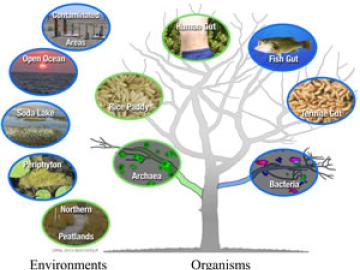Filter News
Area of Research
- (-) Biology and Environment (177)
- (-) Clean Energy (522)
- Advanced Manufacturing (34)
- Biological Systems (18)
- Biology and Soft Matter (5)
- Building Technologies (12)
- Chemical and Engineering Materials (4)
- Chemistry and Physics at Interfaces (11)
- Climate and Environmental Systems (14)
- Computational Biology (6)
- Computational Chemistry (5)
- Computational Engineering (5)
- Computer Science (19)
- Data (1)
- Earth Sciences (1)
- Electricity and Smart Grid (3)
- Energy Frontier Research Centers (14)
- Energy Sciences (5)
- Fossil Energy (3)
- Fuel Cycle Science and Technology (3)
- Functional Materials for Energy (16)
- Fusion and Fission (54)
- Fusion Energy (17)
- Geographic Information Science and Technology (3)
- Isotope Development and Production (3)
- Isotopes (35)
- Materials (432)
- Materials Characterization (2)
- Materials for Computing (36)
- Materials Synthesis from Atoms to Systems (13)
- Materials Under Extremes (12)
- Mathematics (1)
- National Security (79)
- Neutron Data Analysis and Visualization (4)
- Neutron Science (190)
- Nuclear Science and Technology (74)
- Nuclear Systems Modeling, Simulation and Validation (3)
- Nuclear Systems Technology (1)
- Quantum Condensed Matter (4)
- Quantum information Science (9)
- Reactor Technology (1)
- Renewable Energy (4)
- Sensors and Controls (5)
- Supercomputing (311)
- Transportation Systems (11)
News Type
News Topics
- 3-D Printing/Advanced Manufacturing (80)
- Advanced Reactors (6)
- Artificial Intelligence (15)
- Big Data (14)
- Bioenergy (65)
- Biology (79)
- Biomedical (20)
- Biotechnology (16)
- Buildings (36)
- Chemical Sciences (18)
- Clean Water (19)
- Climate Change (58)
- Composites (19)
- Computer Science (41)
- Coronavirus (22)
- Critical Materials (9)
- Cybersecurity (9)
- Decarbonization (47)
- Energy Storage (73)
- Environment (136)
- Exascale Computing (6)
- Fossil Energy (2)
- Frontier (5)
- Fusion (2)
- Grid (41)
- High-Performance Computing (23)
- Hydropower (9)
- Isotopes (2)
- Machine Learning (14)
- Materials (39)
- Materials Science (29)
- Mathematics (5)
- Mercury (10)
- Microelectronics (1)
- Microscopy (15)
- Molten Salt (1)
- Nanotechnology (11)
- National Security (7)
- Net Zero (5)
- Neutron Science (15)
- Nuclear Energy (7)
- Partnerships (12)
- Physics (2)
- Polymers (12)
- Quantum Science (2)
- Renewable Energy (2)
- Security (6)
- Simulation (17)
- Space Exploration (3)
- Statistics (1)
- Summit (13)
- Sustainable Energy (93)
- Transformational Challenge Reactor (3)
- Transportation (66)
Media Contacts





Scientists of the Next-Generation Ecosystem Experiments are blogging from the Arctic this summer. Follow their adventures at http://ngee-arctic.blogspot.com/. Participants share troubles and triumphs from the field in entries with headings like "Flying Wild Alaska" and "Hitting the Tundra." "The b...

Whole-ecosystem warming technologies for the 10- year Spruce and Peatland Responses Under Climatic and Environmental Change project have been finalized using prototypes designed at Oak Ridge National Laboratory. Construction has begun in Minnesota to deploy the technologies, which will warm the...

Through a network that consists of hundreds of low-cost monitors that plug into standard 110-volt outlets, GridEye can play a role in ensuring the reliability of the nation's power grids. The system, developed by researchers at Oak Ridge National Laboratory, provides real-time information about dyna...




